Tamarawindham
On this page, you find all documents, package deals, and flashcards offered by seller tamarawindham.
- 8
- 0
- 0
Community
- Followers
- Following
8 items
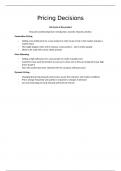
Summary - 3.4.3 Pricing Decisions
The document on "Pricing Decisions" outlines various strategies businesses use to set product prices throughout its life cycle, from research and development to decline. It covers penetration pricing, where low initial prices aim to gain market share; price skimming, where high initial prices capitalize on early demand before lowering them; and dynamic pricing, where prices are adjusted frequently based on customer and market conditions, often using technology to track changes in demand.
- Summary
- • 1 pages •
The document on "Pricing Decisions" outlines various strategies businesses use to set product prices throughout its life cycle, from research and development to decline. It covers penetration pricing, where low initial prices aim to gain market share; price skimming, where high initial prices capitalize on early demand before lowering them; and dynamic pricing, where prices are adjusted frequently based on customer and market conditions, often using technology to track changes in demand.
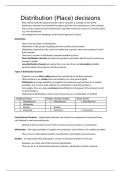
Summary - Distribution (place) decisions
The document on "Distribution (Place) Decisions" outlines the crucial role of place in marketing, encompassing both physical and virtual locations where products are available. It discusses the various distribution channels available to firms, including direct selling, retailing, wholesaling, and e-commerce. Emphasizing the shift towards multi-channel approaches, it explores traditional (long), modern (medium length), and direct (short) distribution channels, detailing the roles of manufacturers...
- Summary
- • 1 pages •
The document on "Distribution (Place) Decisions" outlines the crucial role of place in marketing, encompassing both physical and virtual locations where products are available. It discusses the various distribution channels available to firms, including direct selling, retailing, wholesaling, and e-commerce. Emphasizing the shift towards multi-channel approaches, it explores traditional (long), modern (medium length), and direct (short) distribution channels, detailing the roles of manufacturers...

Summary - Unit cost and Efficiency
The document on Unit Cost and Efficiency explores operational efficiency in business operations, emphasizing how effectively resources like machinery, materials, and labor are utilized to maximize outputs. It introduces LUCC (Labour, Unit Cost, Capacity, Capacity Utilisation) as critical factors for improving efficiency, with methods such as increasing capacity utilization, enhancing labor productivity, and adopting lean production techniques. The concept of unit cost is highlighted as a key ind...
- Summary
- • 3 pages •
The document on Unit Cost and Efficiency explores operational efficiency in business operations, emphasizing how effectively resources like machinery, materials, and labor are utilized to maximize outputs. It introduces LUCC (Labour, Unit Cost, Capacity, Capacity Utilisation) as critical factors for improving efficiency, with methods such as increasing capacity utilization, enhancing labor productivity, and adopting lean production techniques. The concept of unit cost is highlighted as a key ind...
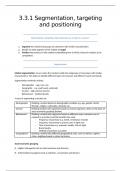
Summary - 3.3.1 on Segmentation, Targeting, and Positioning
Document 3.3.1 on Segmentation, Targeting, and Positioning outlines a strategic approach in marketing. It begins with segmentation, dividing the market into distinct groups based on consumer characteristics. Targeting follows, where specific segments are selected based on factors like profitability and competitive landscape. Finally, positioning determines how a product is perceived relative to competitors, influenced by internal strengths, market conditions, and consumer perceptions. The docume...
- Summary
- • 3 pages •
Document 3.3.1 on Segmentation, Targeting, and Positioning outlines a strategic approach in marketing. It begins with segmentation, dividing the market into distinct groups based on consumer characteristics. Targeting follows, where specific segments are selected based on factors like profitability and competitive landscape. Finally, positioning determines how a product is perceived relative to competitors, influenced by internal strengths, market conditions, and consumer perceptions. The docume...
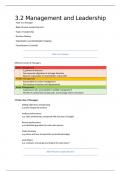
Summary - 3.2 Managers, leadership and decision making
This document explores management and leadership in depth. It covers the roles of managers across different levels, leadership styles including the Blake Mouton Leadership Grid, decision-making processes such as intuition-based and scientific methods like decision trees, stakeholder management and mapping, and the Tannenbaum & Schmidt leadership continuum, which categorizes leadership styles based on managerial authority and subordinate freedom.
- Summary
- • 6 pages •
This document explores management and leadership in depth. It covers the roles of managers across different levels, leadership styles including the Blake Mouton Leadership Grid, decision-making processes such as intuition-based and scientific methods like decision trees, stakeholder management and mapping, and the Tannenbaum & Schmidt leadership continuum, which categorizes leadership styles based on managerial authority and subordinate freedom.
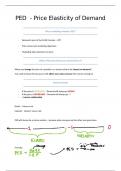
Summary - PED - Price Elasticity of Demand
The document discusses Price Elasticity of Demand (PED) and its relevance to marketing. PED measures how changes in price affect demand, which is crucial for sales revenue. It highlights the inverse relationship between price and demand: increasing prices decrease demand, while decreasing prices increase demand. PED is always negative, reflecting this inverse relationship. Additionally, the document differentiates between elastic (demand changes significantly with price changes) and inelastic (d...
- Summary
- • 1 pages •
The document discusses Price Elasticity of Demand (PED) and its relevance to marketing. PED measures how changes in price affect demand, which is crucial for sales revenue. It highlights the inverse relationship between price and demand: increasing prices decrease demand, while decreasing prices increase demand. PED is always negative, reflecting this inverse relationship. Additionally, the document differentiates between elastic (demand changes significantly with price changes) and inelastic (d...
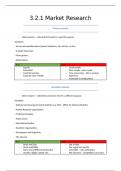
Summary - 3.2.1 Market Research
The document "3.2.1 Market Research" outlines two types of market research: primary and secondary. Primary research involves firsthand data collection for specific purposes, using methods like surveys, interviews, focus groups, and observations. It is specific and controlled but can be time-consuming and expensive. Secondary research utilizes existing data from sources such as government statistics, market research organizations, and academic institutions, which is quick and accessible but may b...
- Summary
- • 2 pages •
The document "3.2.1 Market Research" outlines two types of market research: primary and secondary. Primary research involves firsthand data collection for specific purposes, using methods like surveys, interviews, focus groups, and observations. It is specific and controlled but can be time-consuming and expensive. Secondary research utilizes existing data from sources such as government statistics, market research organizations, and academic institutions, which is quick and accessible but may b...
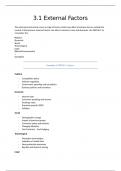
Summary - 3.1 What is Business and External Factors
The document outlines the external factors affecting a business, categorized under the PESTLE+C framework: Political, Economic, Social, Technological, Legal, Ethical/Environmental, and Competition. These factors influence business costs and demand, with examples provided for each category. Additionally, it discusses how market conditions, competition, and environmental issues impact business operations, costs, and demand.
- Summary
- • 3 pages •
The document outlines the external factors affecting a business, categorized under the PESTLE+C framework: Political, Economic, Social, Technological, Legal, Ethical/Environmental, and Competition. These factors influence business costs and demand, with examples provided for each category. Additionally, it discusses how market conditions, competition, and environmental issues impact business operations, costs, and demand.
